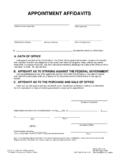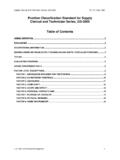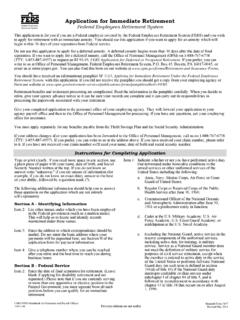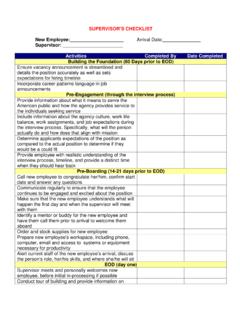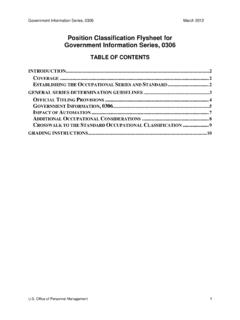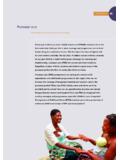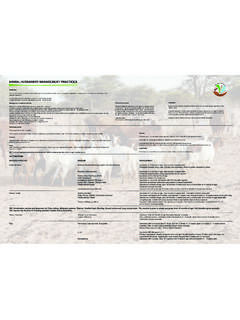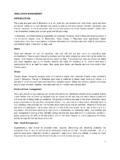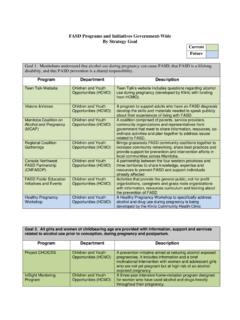Transcription of Guide for Establishing a Federal Nursing Mother’s …
1 January 2013 Guide for Establishing a Federal Nursing Mother s Program1 Table of Contents INTRODUCTION .. 2 DEFINITIONS .. 3 Breastfeeding .. 3 Workplace Support .. 3 Private Space .. 3 LEGISLATIVE BACKGROUND .. 4 Time for Breaks .. 4 Location of Breaks .. 4 Compensation .. 4 BENEFITS .. 5 For Agencies .. 5 For Mothers .. 6 For Babies .. 6 AGENCY GUIDANCE: Establishing A WORKSITE PROGRAM .. 7 What is Expected in a Nursing Mother s Program .. 9 Going Above and Beyond the Standard Nursing Mother s Program .. 9 Best Practices .. 10 Federal AGENCIES WITH SUCCESSFUL WORKSITE PROGRAMS .. 12 On-site rooms equipped with breast pumps for employees, contractors, and visitors.
2 13 RESOURCES .. 15 REFERENCES .. 20 Appendix A: Check List for Creating a Nursing Mother s Room .. 21 2 INTRODUCTION Section 4207 of the Patient Protection and Affordable Care Act (ACA) revises the Fair Labor Standards Act (FLSA) by requiring employers to provide Nursing mothers with 1) reasonable break time to express milk for one year after her child s birth each time such employee has need to express breast milk; and 2) a private space, other than a bathroom, that is shielded from view and free from intrusion of others, to express breast milk. This legislation has significant impact on worksite accommodations for Nursing mothers. In the United States, over one-third of all mothers working outside the home have children younger than two years of age.
3 Many of these mothers desire and intend to exclusively breastfeed until their babies reach six months of age, at minimum. However, according to the Centers for Disease Control and Prevention, while 75 percent of mothers in the United States breastfeed from the start, only 22% of babies are still breastfed by the twelve-month mark. There are many reasons why Nursing mothers are unable to breastfeed for as long as they desire and returning to work is a primary factor (Wenjun, & Acosta, 2002). When working mothers receive workplace support, such as adequate space and time to express milk, support from supervisors and colleagues, and education, they are often able to continue to successfully breastfeed their child.
4 Another complicating factor is lack of privacy in the workplace, as well as the commonly held fear that Nursing mothers will be perceived as less productive if they choose to express breast milk during the workday. The ACA addresses these concerns. The American Academy of Pediatrics recommends breastfeeding exclusively for at least the first six months after birth and, ideally, until or after the child is twelve months of age. The World Health Organization, the Surgeon General s Office, and the American Academy of Family Physicians agree. For example, the Surgeon General released a Call to Action in 2011 to support breastfeeding. Several action items were directed toward employment, such as ensuring that employers establish and maintain comprehensive, high-quality Nursing mothers support programs for employees.
5 In addition, the Healthy People Initiative, managed by the Office of Disease Prevention and Health Promotion at the Department of Health and Human Services (HHS), includes a goal for increasing the number of workplaces that provide Nursing mothers support services from 25% to 38% of workplaces. Continued breastfeeding offers a variety of noted benefits for mothers, their babies, and their employers. The ACA facilitates the continuation of breastfeeding and helps Nursing mothers to better integrate their work and family needs. Many agencies go beyond the requirements of the legislation to actively support Nursing mothers through various programs, resources, and facilities.
6 3 DEFINITIONS Breastfeeding It is difficult to assign a single definition to the term breastfeeding, because there are multiple behaviors that constitute breastfeeding. The term may be used in reference to full breastfeeding, partial breastfeeding, token breastfeeding, or exclusive expression of milk using a breast pump (Labbok & Krasovec, 1990). Moreover, within the categories of full and partial breastfeeding are further subtopics. Full breastfeeding is understood to be either exclusive breastfeeding (no other liquid or solid is given to the baby) or almost exclusive breastfeeding (vitamins, water, or other liquids are given to the baby occasionally in addition to breastfeeding).
7 Partial breastfeeding includes varying levels of breastfeeding. Token breastfeeding refers to breastfeeding that is not for nutritive purposes. Rather, it is breastfeeding conducted for comfort and consolation to the infant. Token breastfeeding is minimal, infrequent, and irregular. The final category of breastfeeding is exclusive pumping. Some women may choose to exclusively pump breast milk for a variety of reasons. For example, it is sometimes more difficult to nurse babies with cleft palates or those born prematurely, or the mothers had early difficulties getting the baby to latch at the breast. Workplace Support As the Nation s largest employer, the Federal Government strives to be a groundbreaker in the development of wellness programs and policies, including support for breastfeeding.
8 The level of support provided to Nursing mothers currently varies across workplaces. Support for breastfeeding in the workplace is defined by a variety of characteristics. These may include offering benefits and services to employees; educating employees about breastfeeding; providing time and space for Nursing mothers to express breast milk; allowing flexible schedules for break time; providing mothers with the option to telework or work part-time; providing access to or resources for childcare; providing breast pumps or discounts to purchase breast pumps; offering lactation services and consultants; and providing an effective Nursing mother s program and facility.
9 OPM urges agencies to support all Nursing mothers to the fullest extent possible. Private Space A room for Nursing mothers is private space a Nursing mother can use to express milk. This space must be shielded from view and free from intrusion of others. A Nursing mother s room must be functional, with a private space with a place to sit and a flat surface, other than the floor, to place the breast pump and other supplies. Although there are no size or permanency requirements, these rooms should provide access to electricity for the use of a breast pump, as well as good lighting, a comfortable temperature, and proper ventilation. Further, a room for Nursing mothers should be clean and agencies should provide cleaning wipes and paper towels.
10 Nursing mother s rooms with exceptional accommodations may include a breast pump provided 4 by the agency, refrigerator, microwave for sterilization of breast pump parts, comfortable chair, table, clock, mirror, and sink. LEGISLATIVE BACKGROUND The Affordable Care Act added a new subsection (r) to section 7 of the Fair Labor Standards Act (FLSA), requiring employers to provide Nursing mothers with: 1) a reasonable break time to express milk for one year after her child s birth each time such employee has need to express breast milk; and 2) a private space, other than a bathroom, that is shielded from view and free from intrusion of others, to express breast milk.

